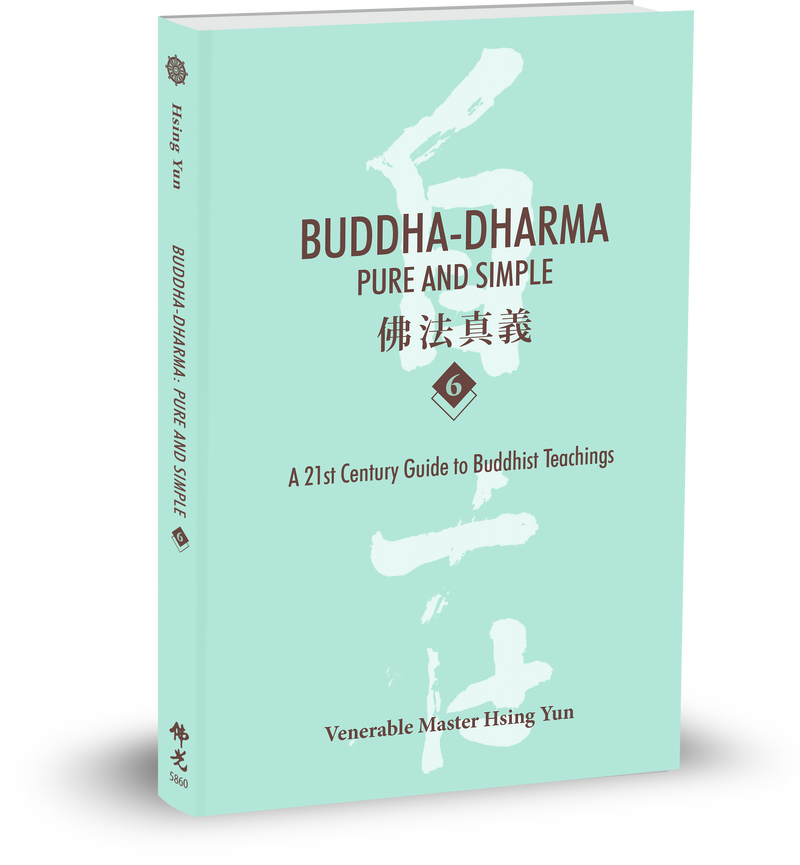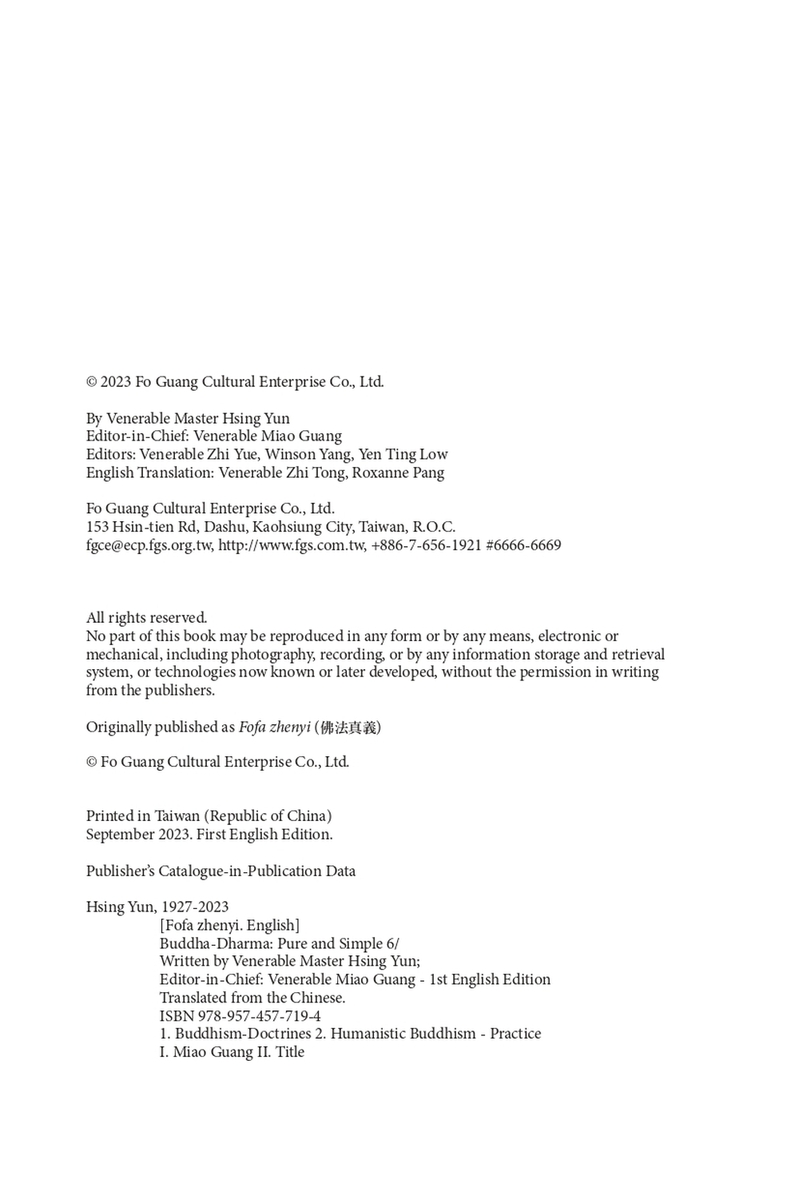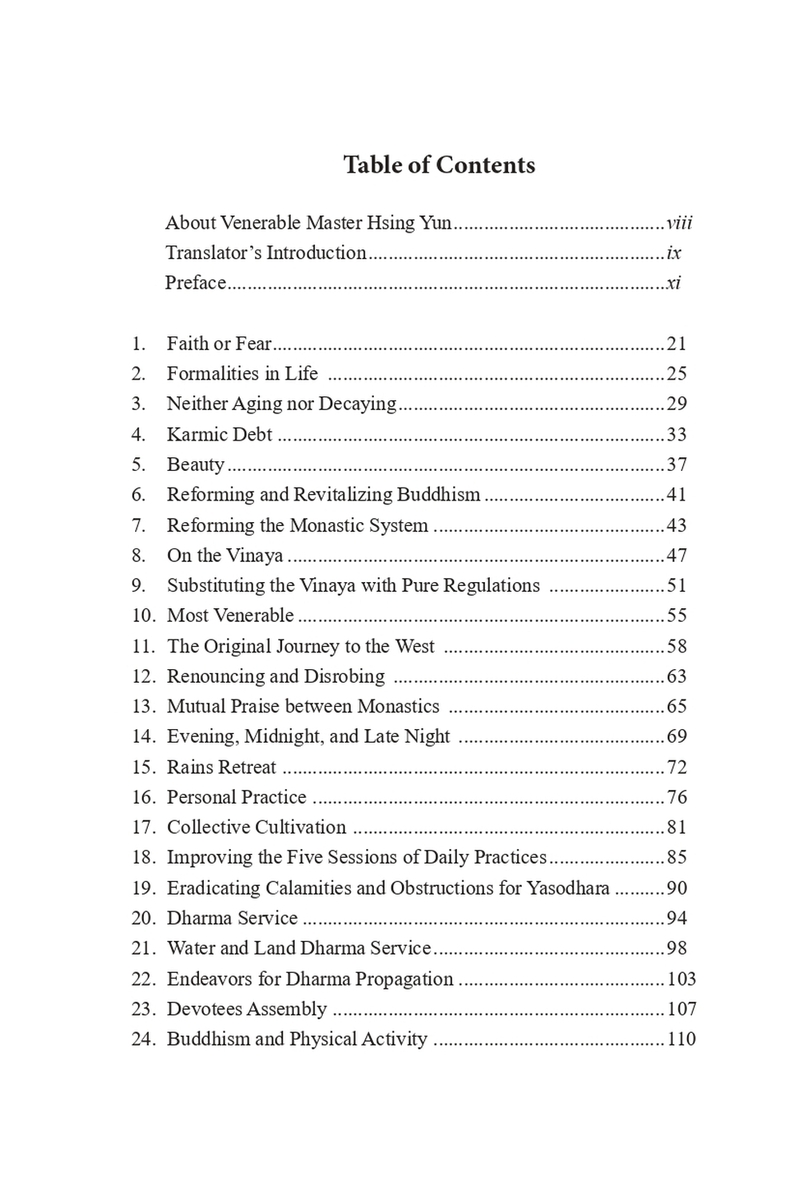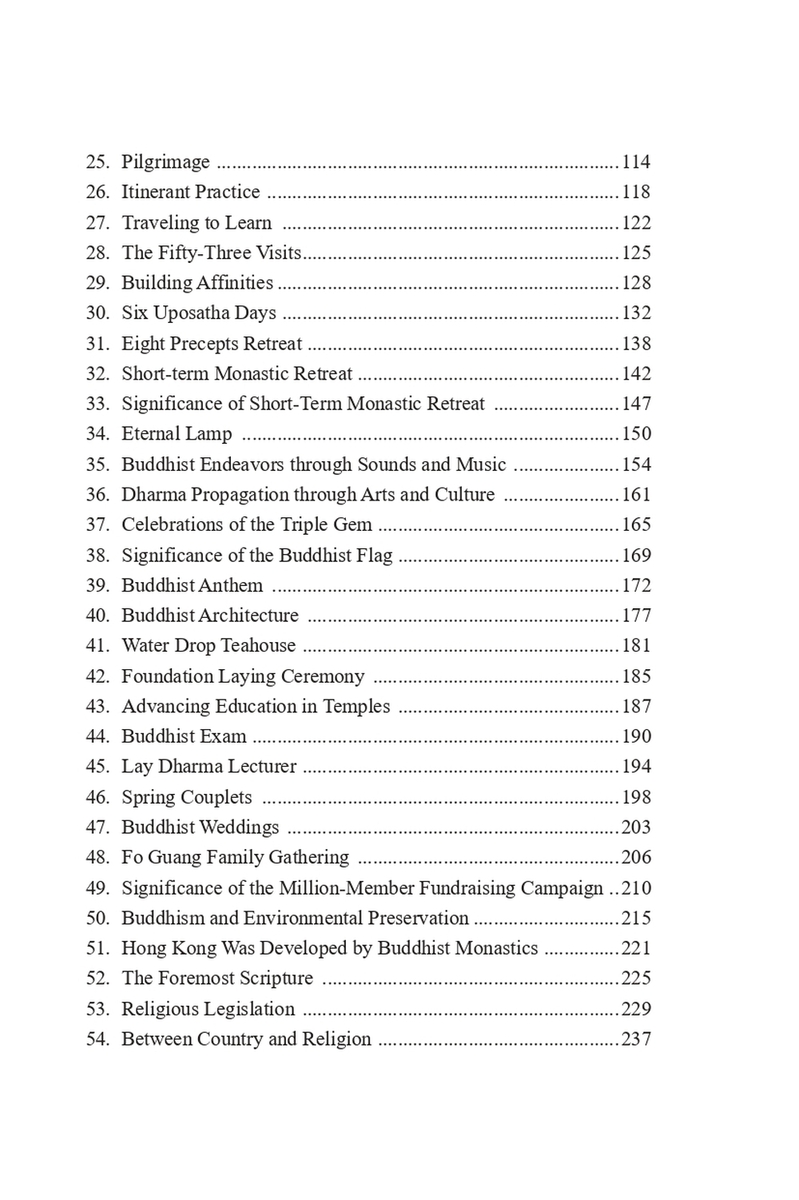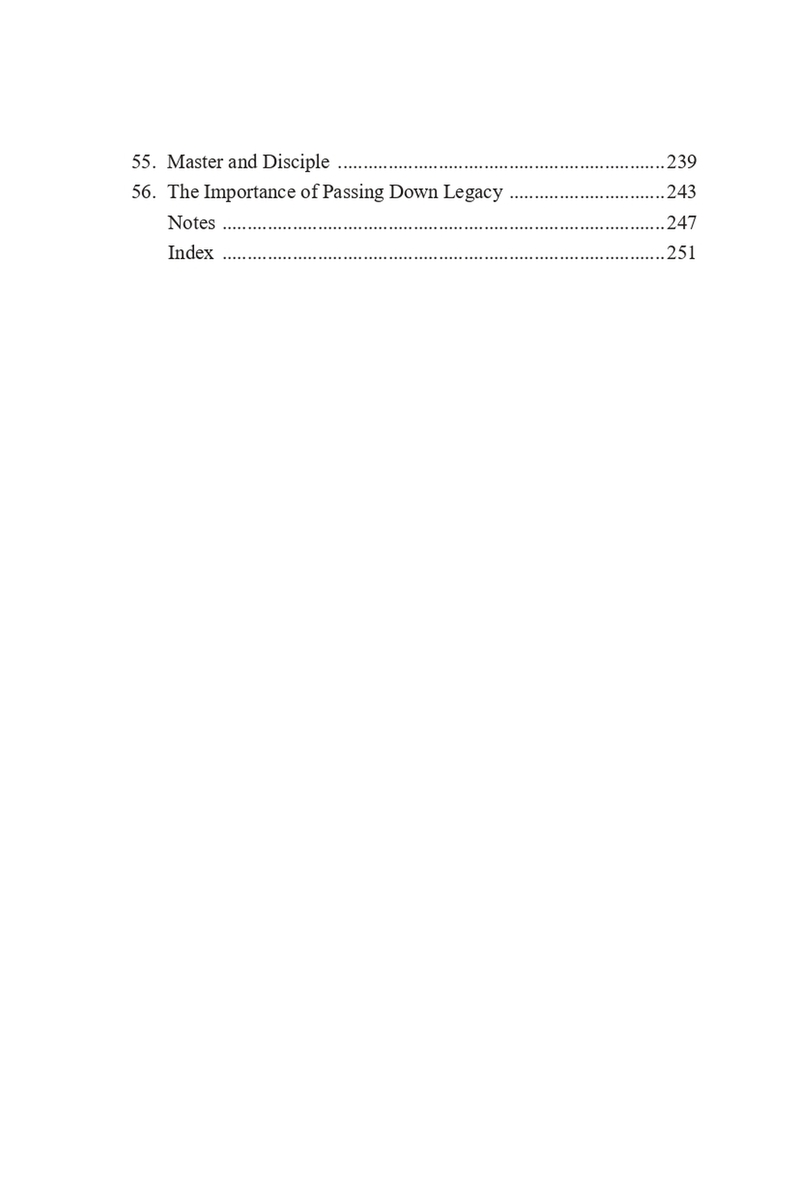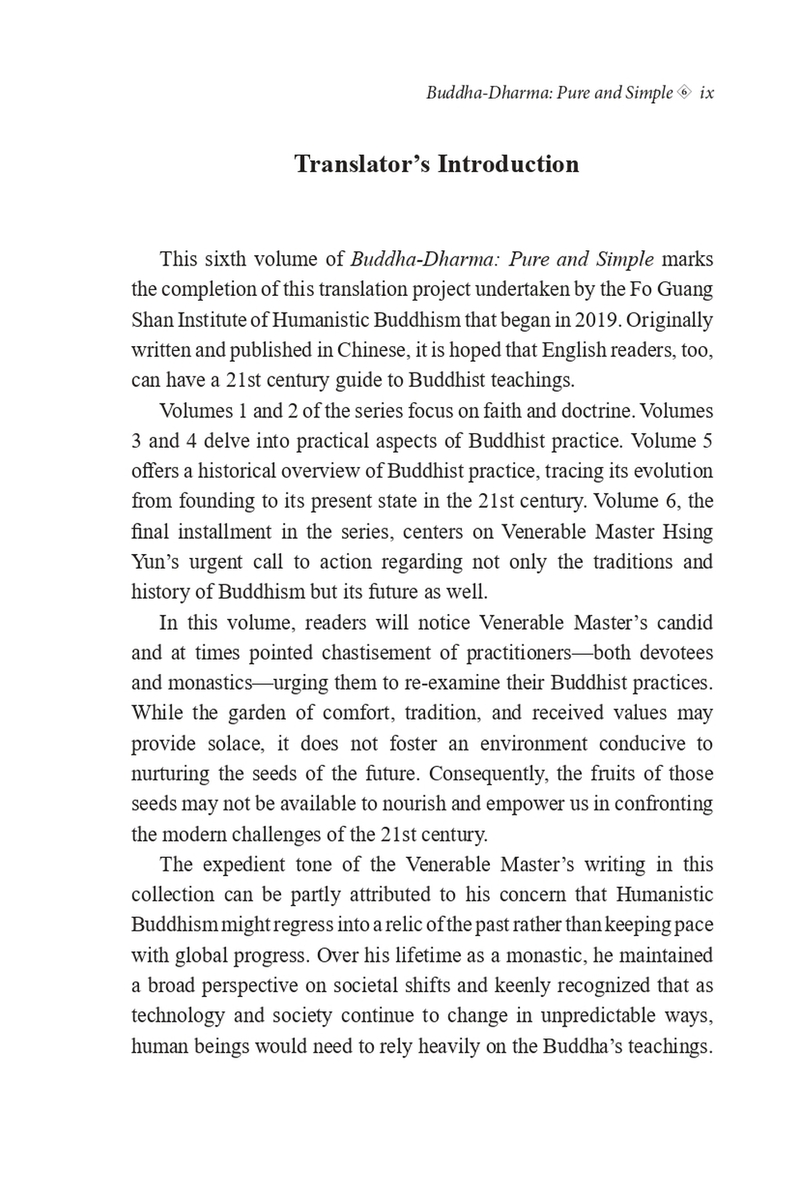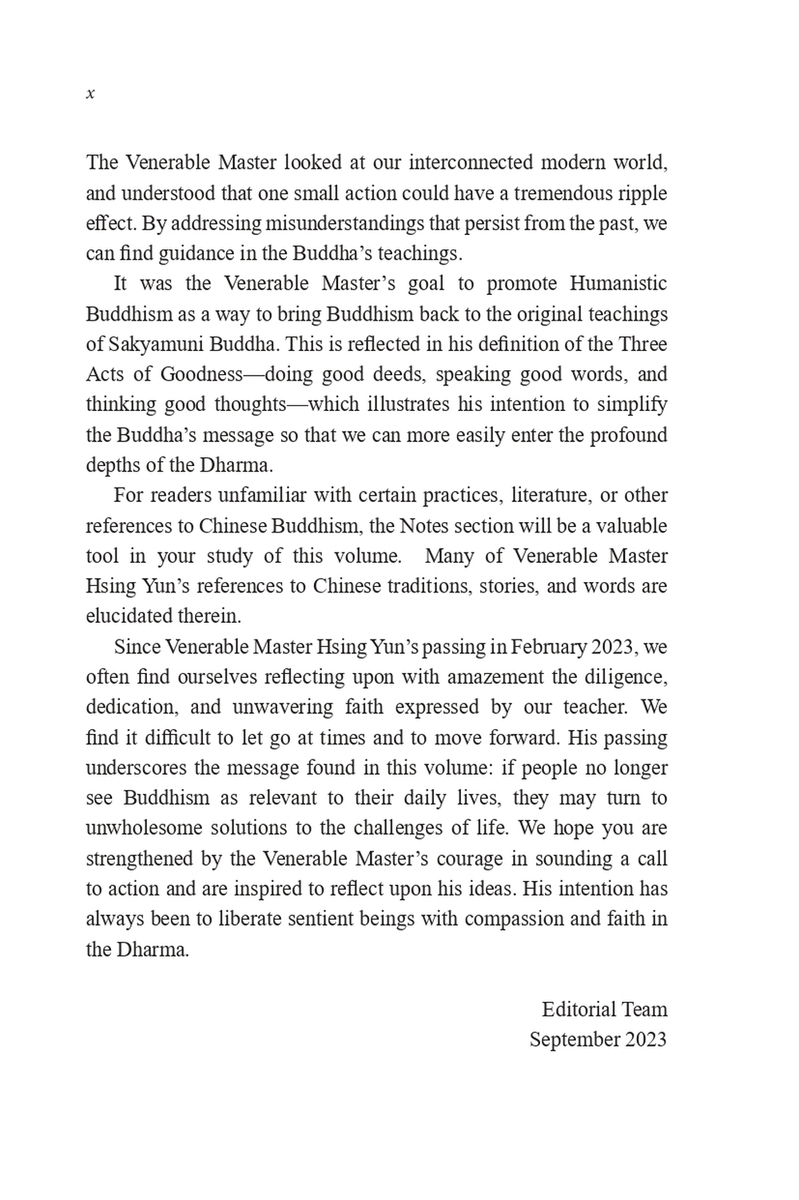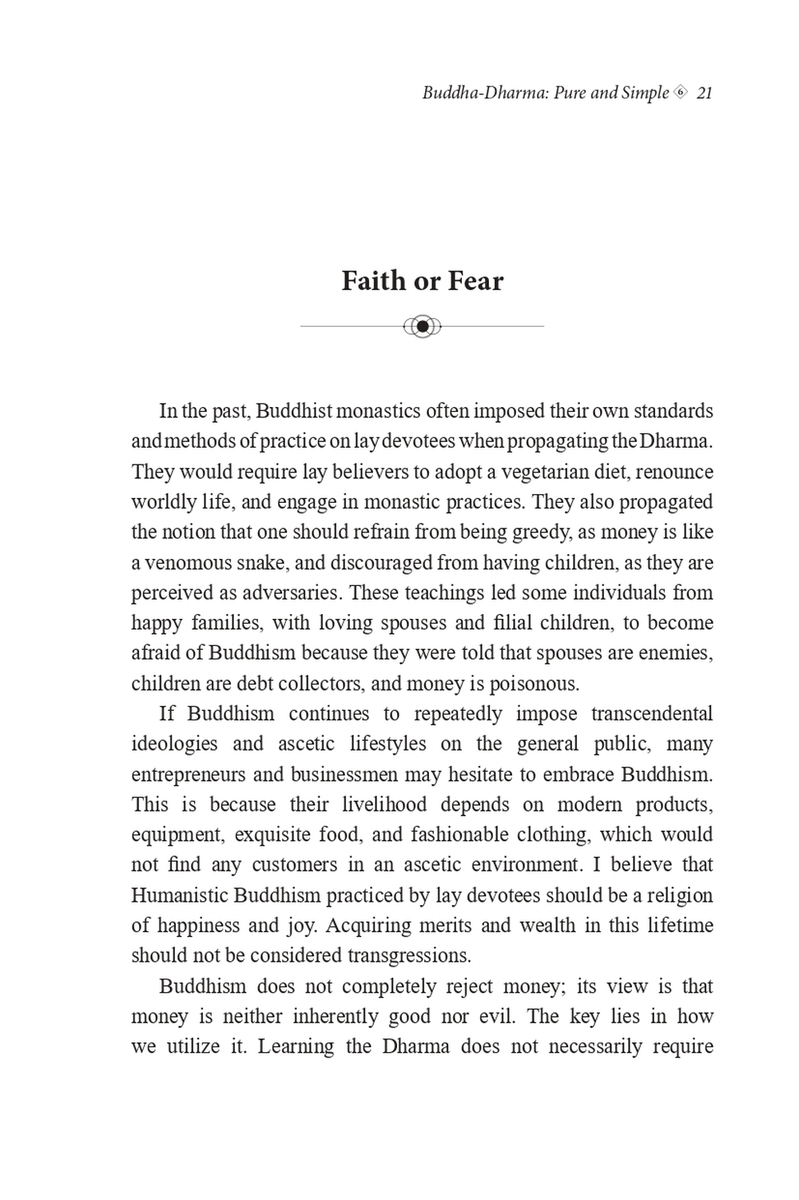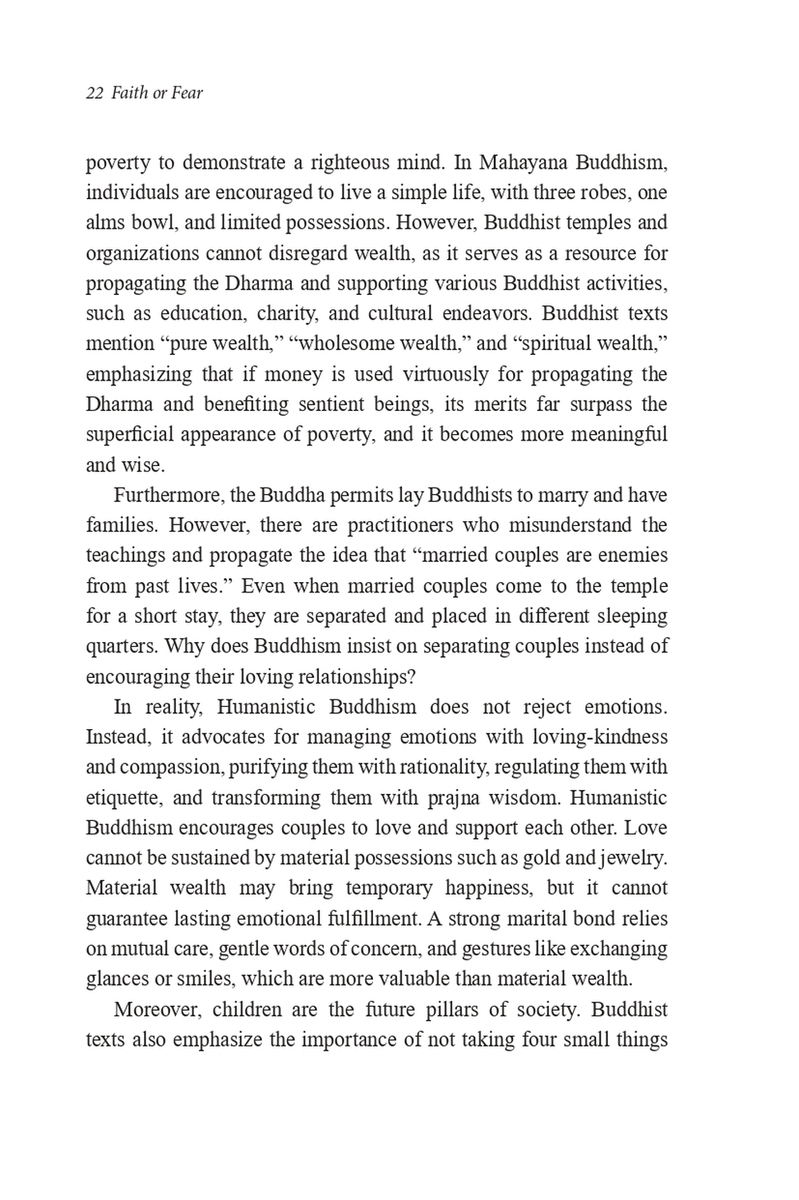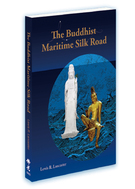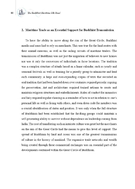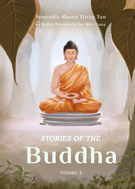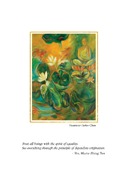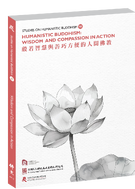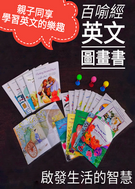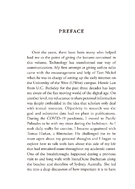In today’s Buddhist sphere, numerous claims have been made on what the Buddha has taught. However, were they truly spoken by the Buddha? The Buddha-Dharma: Pure and Simple series is an exploration of over 300 topics, where Venerable Master Hsing Yun clarifies the Buddha’s teachings in a way that is accessible and relevant to modern readers. Erroneous Buddhist views should be corrected, the true meaning of the Dharma must be preserved in order to hold true to the original intents of the Buddha.
About Venerable Master Hsing Yun
Translator’s Introduction
Preface
-
Faith or Fear
-
Formalities in Life
-
Neither Aging nor Decaying
-
Karmic Debt
-
Beauty
-
Reforming and Revitalizing Buddhism
-
Reforming the Monastic System
-
On the Vinaya
-
Substituting the Vinaya with Pure Regulations
-
Héshàng (Most Venerable)
-
The Original Journey to the West
-
Renouncing and Disrobing
-
Mutual Praise between Monastics
-
Evening, Midnight, and Late Night
-
Rains Retreat
-
Individual Practice
-
Collective Cultivation
-
Improving the Five Daily Duties OR Improving the Five Sessions of Cultivation?
-
Eradicating Calamities and Obstructions for Yasodhara
-
Dharma Service
-
Water and Land Dharma Service
-
Endeavors for Dharma Propagation
-
Devotees Assembly
-
Buddhism and Physical Activity
-
Pilgrimage
-
Itinerant Practice
-
Traveling to Learn
-
The Fifty-Three Visits
-
Building Affinities
-
Six Days of Purification
-
The Eight Precepts
-
Short-term Monastic Retreat
-
Significance of Short-Term Monastic Retreat
-
Eternal Lamp
-
Buddhist Endeavors (foshi) through Sounds and Music
-
Dharma Propagation Through Arts and Culture
-
Celebrations of the Triple Gem
-
Significance of the Buddhist Flag
-
Buddhist Anthem
-
Buddhist Architecture
-
Water Drop Teahouse
-
Foundation Laying Ceremony
-
Advancing Education in Temples
-
Buddhist Examination
-
Lay Dharma Lecturer
-
Spring Couplets
-
Buddhist Wedding
-
Fo Guang Family Gathering
-
Significance of the Million-Member Fundraising Campaign
-
Buddhism and Environmental Preservation
-
Hong Kong Was Developed by Buddhist Monastics
-
Religious Legislation
-
Between Country and Religion
-
Master and Disciple
-
The Importance of Passing Down Legacy
Notes
Index
Preface
The metaphors of three birds flying in the sky and three animals crossing the river have frequently been used in the Buddhist sutras to depict the notions of distance and depth perceived differently by different beings. Though the concept of distance within the vast sky is inherently non-existent, at the flap of their wings, an eagle, a pigeon, and a sparrow would span distances ranging from tens of miles to only a couple of miles, and merely a few yards depending on their varying abilities. As a result, the idea of distance is very different to these three birds.
In the same way, when an elephant, a horse, and a rabbit cross the river, the elephant’s enormous body enables it to tread across the riverbed and reach the far shore without difficulty, while the horse and rabbit, unable to reach the bottom of the river, will struggle as they swim across the river.
The Buddha-Dharma is like the deep ocean or the vast sky. While people may hold opinions on the differences in levels, there is no saying who is right or wrong, because different levels of faith and spiritual aptitude mean different levels of knowledge. There is no need to think highly of oneself. Which one are you when crossing the river? The elephant? The horse? Or the rabbit? Which one are you in the sky? The eagle? The pigeon? Or the sparrow? One must constantly self-evaluate.
The Buddha’s teaching is kind, compassionate, wise, and equal. However, how can we know we have truly understood the profundity of the teaching?
If one wants to know the length of a fabric or the weight of an object, one must measure or weigh it. Similarly, we need to measure and weigh the Dharma we think we have understood to know the depth of our faith. Otherwise, we are like a kindergartener who forcefully claims to be a university student, revealing our ignorance to everyone.
Is it possible for today’s Buddhists to explain the true meaning of Buddhism without going against the original intents of the Buddha? For example, the concept of heaven and hell is to encourage people to transcend and not regress in their spiritual cultivation. However, some ignorantly use the concept of hell to inflict fear upon devotees. Why not use the goodness of heaven as encouragement for the people?
There is also the issue of being grateful for the contribution and support devotees give to Buddhism. Often people say, “Amitabha Buddha will be grateful for your contributions.” Why are we asking Amitabha Buddha to help us express our gratitude? How can we push this responsibility away? Are we not the ones who should repay this kindness and contribution?
Suffering, the fundamental teachings of Buddhism, is a concept that should motivate us to endure hardships, to be hardworking, to train ourselves through austerities because adversity makes us stronger and better. Even a student needs to undergo a decade of education to achieve success and recognition. Hence, suffering makes our lives more meaningful. As the saying goes, “Out of the worst of the worst pains emerges the best of the best people.”
Buddhists today, however, often exclaim, “Suffering! Suffering! Live no more! Pass away now! Pray to pass away now!” This is not the reason why the Buddha expounded the truth of suffering. By properly understanding suffering, it pushes us to transcend and be liberated from it. Have these people not been giving the wrong interpretations?
For thousands of years, people think the Buddhist term “emptiness” or the saying “the four elements are empty” means that nothing exists, that there is nothing to possess, and that everything is empty. As Dharma propagators, how can we elevate people’s faith with this nihilistic and ignorant kind of view?
Emptiness is meant to be constructive; with emptiness comes existence. For example, where would you sleep if there are no empty rooms? Where would you work if there is no empty desktop to work on? Where would you build a house if there is no empty land? Where would you put your money if your pockets are not empty? How could you survive if your stomach is not empty? Emptiness is so good, so wonderful! So why explain emptiness as nihilism? Emptiness is meant to be full of action, potential, and success.
The same goes for the concept of impermanence. Impermanence is wonderful because it means that nothing is fixed; we can thus change, improve, and transcend. Situations can become better, more wholesome, and beautiful. So why make it sound like everything in this world is coming to an end when we explain impermanence? Why make people feel so hopeless? Impermanence is a beacon of hope for Buddhists to learn about the Middle Way. We have failed to attain the true meaning of Buddhism and thereby misunderstood the intentions of the Buddha. Thus, we must research and restore the true meaning of these Buddhist teachings, and propagate them.
For over two thousand years, the Buddha has carried the indignity of those who have been propagating deviant and false views, going against his intents, teaching the Dharma through misunderstanding, superstition, and skewed perspectives, all done in his name.
Take the practice of giving as an example. Sometimes, giving others a phrase, a smile, or a service are all acts of giving. However, today’s Buddhism explains giving in terms of a monetary donation. The practice of giving does not only mean we ask others to give, but we should be the ones who are willing to let go and offer.
Upholding precepts is another cultivation on the path of learning Buddhism. However, it is usually spoken from the perspective of telling others to uphold and follow. What about our actions, minds, and speech? Are they following with the Dharma? If we do not have a painful sense of remorse, how can we improve as Buddhists?
In An Inspiration to Give Rise to the Bodhi Mind, Venerable Sheng’an said, “The main gate for entering the Path is to first give rise to aspirations.” To give rise to aspirations means to have right faith and right view. Simply put, the way to practice Buddhism is to cultivate loving-kindness, compassion, joy, and equanimity, the Four Means of Embracing, and the Six Paramitas. However, today, we teach devotees that the practice of the Six Paramitas consists only of offering incense and venerating in the temple, believing that the act of donation can eradicate calamities. Therefore, Huineng the Sixth Patriarch admonished in the “Gatha of Formlessness”, “Attaining buddhahood does not come from giving money.” However, how many Buddhists have ever taken in the Sixth Patriarch’s teachings?
We need to raise the issue of correcting erroneous views about Buddhism so that the true meaning of the Buddha will not be lost, and enhance deeper and proper understanding of the Buddha’s original intents. Take the practice of life-releasing as an example. To hold a life-releasing ceremony, they first must catch fish and birds, and who knows how many lives were killed in the process? So, for those who hold a life-releasing ceremony for longevity, how can they live a long life?
There are also people without the right understanding of the law of cause and effect, thinking that becoming vegetarians makes them healthy, or praying to the Buddha leads to the acquirement of wealth and fortune. This would be going against the law of cause and effect. There are relative causes and effects for the accumulation of wealth, health, and faith. How can we expect to harvest beans when we planted melons?
Some people deceive with deeds such as acquiring good fortune by being the first to strike the bell or offer incense on Chinese New Year, turning these activities into superstitions that are not in accord with the Dharma. These people do not understand that the sound of the bell is only to alert us to do good, and the burning of incense is an act of offering to the Buddha and should not be done for profit. Moreover, various practices of fortune-telling focus only on praying for wishes to be fulfilled, instead of focusing on Buddhist cultivation. How can these acts be in accord with cause and effect?
What about the geomantic principle of feng shui? Everything has its own principle. For example, there are principles for social interaction, principles for relationships, and principles of material objects. Of course, the geographical environment has its principle. However, geomancy should not only be about searching for the best feng shui for good luck. If your living environment has good air circulation, is hygienic, is balanced with an open view, then it is already in the best geomantic position. Just look at Xuankong Temple (lit. Hanging Temple) in Shanxi, Mainland China. Do you think the location can be deciphered with geomancy?
Buddhism talks about the Eight Groups of Heavenly Beings. Where is heaven? What are the eight groups? We can describe them as different ethnic groups, instead of heavenly gods and armies.
It is said that the Buddha was born from the right flank of his mother. Did anyone witness this? Why attach so many far-fetched legends to the Buddha? What about the Buddhist Councils? There are always people with ulterior motives that include apocryphal sutras and commentary into the Buddhist canon, all under the name of the Buddha.
Buddhism has always been mocked as a polytheistic religion because of the many bodhisattvas and arhats who exist. Moreover, most of these figures are only mentioned in the sutras and are not real historical figures. Those with historical references such as Nagarjuna, Asanga, and Vasubandhu are truly acknowledged. For those with no historical references, who were their parents? Where did they grow up? We need not deny them. Rather, we can consider them as manifestations of the Buddha.
Why not place the focus of the faith on the Buddha instead? Why the need for so many deities such as the god of wealth, god of the city, god of the hearth, goddess of birth, and the god of love? We say that gods created humans, but humans also created gods. Buddhism differs from other religions in that the Buddha was an awakened human being. He had a historical background, he truly was a human being, not gods and goddesses that arose from imagination or hearsay. Therefore, the Buddha is the greatest awakened one. Why do Buddhists not return to the Buddha his original face?
Hapless Buddha! For two thousand years, he has been shrouded with the coat of superstition and obscured by the masks of deities and ghosts by the so-called devotees. It is a great pity that the Buddha should lose his original identity.
For example, Buddhism talks about the Four Immeasurable Vows so that we can make vows and practice them. But today, Buddhists only talk the talk, they dare not walk the walk. If no one practices, what use is there for the Four Universal Vows?
Another example is that the Buddha taught the Six Paramitas so that we understand these as the ways to practice the Bodhisattva Path. The paramitas of generosity, precept, patience, diligence, meditative concentration, and prajna wisdom are practices of delivering self and others. However, monastics today hold others to the standard of the Six Paramitas, yet they themselves do not give. They wish only to receive. Resultantly, the devotees are the ones who get delivered, while we are still stuck on the other shore. What to do? Monastics go through the teachings of the Buddha for the sake of finding ways to receive gains and benefits. The development of this type of perverse thinking and action can only be subject to the future ruling of the law of cause and effect. There is no law today that ensures the Buddha’s teaching is exercised according to his original intents.
The foremost practice in this world is the Noble Eightfold Path. In the past, foreigners from the Western regions tried to explain the Noble Eightfold Path, hence the coining of the term hú shuō bā dào. However, this term has become an insult for people talking nonsense. How can we answer to the people from the Western regions?
Between the Sui and Tang Dynasty, some young practitioners studied with eminent Buddhist masters. For a time, they either studied under Chan Master Mazu in Jiangxi, or Chan Master Xiqian in Hunan. The term “roaming Jianghu” refers to their deeds of traveling and learning. However, such a meaningful term has come to mean vagabonds performing their monkey tricks. Who will be the one to correct this?
In Buddhism, we also see sutras such as the Vimalakirti Nirdesa Sutra and Srimaladevi Simhanada Sutra. Are Layman Vimalakirti and Lady Srimala not lay Dharma teachers? Why do we think that the Age of Declining Dharma is near when lay professors and devotees are teaching the Dharma? This obstructs many outstanding Buddhists from propagating Buddhism. Does fault not lie with those who keep promoting these kinds of deviant sayings?
Another example is the term “eternal life.” Originally, this Buddhist term means that life does not end in death but continues in the cycle of samsara. However, when Christians promoted that believers will have eternal life, Buddhists were afraid to use this term. Another term is “savior.” The Buddha truly is a savior, for he came to this world to deliver all beings. However, because Christianity proclaimed Jesus Christ the savior, Buddhism was afraid to call the Buddha a savior. Such beautiful terms are adopted by other religions, while the Buddha becomes associated with improper faiths, miraculous and ghostly incidents, as well as deviant thoughts and views.
The Vinaya notes that should a person “handle alcohol, one will be reborn without hands for five hundred lifetimes.” How can such a serious punishment exist? Which eminent master established this precept? This person did not understand the original intents of the Buddha and chronicled such a deviant saying due to improper understanding and lack of common sense. Moreover, on the issue of the Ten Sramanera Precepts, research should be conducted on how many Buddhist elders truly uphold them. These precepts cannot even be fully upheld by senior monks, how can we expect newly tonsured sramaneras to uphold them? Is this not nonsensical?
On the term the “Eight Garudharmas,” from my understanding, the Buddha promoted equality, as can be seen in the saying, “When beings of the four castes leave the householder's life, they all together join the Sakya clan.” So, how can the Eight Garudharmas promote gender inequality? Which eminent master established these precepts and makes people uphold them in the name of the Buddha? In Buddhism, taking refuge shows the spirit of democracy and upholding the Five Precepts signifies freedom. The Buddha advocated equality among the Four Groups of Disciples. Why not combine the wonderful Dharma with today’s universal values of freedom, democracy, and equality?
In the Buddhist sphere of today, numerous people claim this or that are the words of the Buddha. However, were they truly spoken by the Buddha? On the contrary, how can we claim that this and that were not spoken by the Buddha? Whatever the Buddha did say and do, we will practice it as the Dharma teaching. We now advise others to practice as the Buddha did, to learn from the Buddha, to be a buddha, to believe that “I am buddha.” However, we must be careful not to wrong the Buddha and use his name to instruct while still clinging to our attachments and deviant views. Such actions shall bring serious consequences.
Today’s Buddhists have become volunteers for Buddhism. They offer to protect their faith. They embrace Buddhism. But, what has Buddhism given to these devotees in return?
Once, when I was presiding over a Taking Refuge and Five Precepts Ceremony, a devotee refused to take the precepts out of fear of taking the precept of no lying. It was because he had heard about the story of a Chan Master who was reborn as a fox for five hundred lifetimes from having claimed that great practitioners are “not subjected to karma” when he had meant that they too were “subjected to karma.” This devotee was terrified that he might lie. I believe that when other Buddhists hear of his reason, they would dissuade him from taking the precepts.
Instead of worrying about lying, one can choose to practice Right Speech. Once there was a Buddhist who owned a textile store, and when customers wanted to buy a piece of cloth, they would ask,
“How much for a foot of fabric?”
“Five dollars.”
“Does the color fade?”
To sell the cloth, he would lie and say, “No, it doesn’t.”
Later, I suggested that he could say, “The five-dollar fabric fades easily, but the eight-dollar one does not.” Due to the honorable reputation he gained from being honest, his business boomed, which allowed him to build an establishment. Dharma brings goodness to all. My only concern is, why do people not positively explain Buddhism so devotees can receive the benefit of the Dharma?
The Buddha-Dharma: Pure and Simple is a series of nearly 300 topics that address my understanding of the subjects that I encounter daily. The problems confronted by Buddhism lie deeper. I just hope some determined people will reassess Buddhism as a whole, and return to Buddhism its original meaning so that the true teachings of the Buddha can pervade in this world.
Certainly, as Buddhism spread, it has evolved according to the cultures, languages, traditions, people, and climates of different geographical regions. Thus, skillful means required to enhance the process of dissemination have certainly become a matter of fact.
In Chinese Buddhism, only succeeding generations of Chan Masters still possessed some Right View and understood some of the Dharma. Few people continue to research and propagate the true Dharma that other schools taught-for example, the “Dependent Origination and the Middle Path” of the Three Treatise School. As the saying goes, “Deviant faiths arise when right faith declines.” I intend for this book to be a catalyst for all to think outside the box. Should any ideas presented in this book sound incomplete, I sincerely apologize. My humble hope is only that it mirrors the intentions of the Buddha so that all may reassess the true meaning of the Buddha-Dharma. I am grateful and humble accept any understanding and comments that reflect my intentions.
Hsing Yun
May 2016
Founder’s Quarters, Fo Guang Shan
Faith Or Fear
In the past, Buddhist monastics often imposed their own standards and methods of practice on lay devotees when propagating the Dharma. They would require lay believers to adopt a vegetarian diet, renounce worldly life, and engage in monastic practices. They also propagated the notion that one should abstain from being greedy, as money is like a venomous snake, and discouraged having children, as they are perceived as adversaries. These teachings led some individuals from happy families, with loving spouses and filial children, to become afraid of Buddhism because they were told that spouses are enemies, children are debt collectors, and money is poisonous.
If Buddhism continues to demand that the general public adopt transcendental ideas and ascetic lifestyles, many entrepreneurs and businessmen would hesitate to embrace Buddhism. This is because their livelihood depends on modern products, equipment, exquisite food, and fashionable clothing, which would not find any customers in an ascetic environment. I believe that Humanistic Buddhism practiced by lay devotees should be a religion of happiness and joy. Acquiring merits and wealth in this lifetime should not be considered sinful.
Buddhism does not completely reject money; its view is that money is neither inherently good nor evil. The key lies in how we utilize it. Learning the Dharma does not necessarily require poverty to demonstrate a righteous mind. In Mahayana Buddhism, individuals are encouraged to live a simple life, with three robes, one alms bowl, and limited possessions. However, Buddhist temples and organizations cannot disregard wealth, as it serves as a resource for propagating the Dharma and supporting various Buddhist activities, such as education, charity, and cultural endeavors.
Furthermore, the Buddha permits lay Buddhists to marry and have families. However, there are practitioners who misunderstand the teachings and propagate the idea that “married couples are enemies from past lives.” Even when married couples come to the temple for a short stay, they are separated and placed in different sleeping quarters. Why does Buddhism insist on separating couples instead of encouraging their loving relationships?
In reality, Humanistic Buddhism does not reject emotions. Instead, it advocates for managing emotions with loving-kindness and compassion, purifying them with rationality, regulating them with etiquette, and transforming them with prajna wisdom. Humanistic Buddhism encourages couples to love and support each other. Love cannot be sustained by material possessions such as gold and jewelry. Material wealth may bring temporary happiness, but it cannot guarantee lasting emotional fulfillment. A strong marital bond relies on mutual care, gentle words of concern, and gestures like exchanging glances or smiles, which are more valuable than material wealth.
Moreover, children are the future pillars of society. Buddhist scriptures also emphasize the importance of not taking four small things lightly, including children. So why do we refer to our children as “debt collectors?” If parents raise their children well and instill them with correct values from an early age, nurturing their spiritual growth with the water of truth, they will flourish and be able to offer support to many others. Thus, children are not debt collectors; they are the objects and companions of their parents’ spiritual cultivation.
Therefore, I continually advocate for the importance of ethical and moral relationships, promoting harmonious and purified family dynamics. If lay devotees view money as venomous snakes, spouses as enemies, and children as debt collectors, it will only discourage more people from approaching Buddhism.
Buddhism is a religion of happiness and well-being. The faith brings brightness, goodness, and beauty into our lives, allowing us to transcend fear. Hence, Buddhist practitioners should embody a “humanistic character.” They can lead a simple and contented life with a transcendent mindset, while also employing skillful means to engage with the world. If intimidation becomes the consistent approach, it will inevitably hinder the development of Buddhism.
Venerable Master Hsing Yun is the founder of the Fo Guang Shan Buddhist Order. A Buddhist monk for over eighty years, he has dedicated his entire life to propagating the teachings of Humanistic Buddhism throughout the world.
購物說明
*商品示意圖謹供參考,請以實際供貨為準。
*郵寄單筆滿299元免運(海外運費另計);未滿299元時,運費60元。
*郵寄貨到付款單筆滿699免運(海外運費另計);未滿699元時,運費100元。
*為了保障您的權益,佛光讀友所購買的商品均享有到貨七天的鑑賞期(含例假日)。退回之商品必須於鑑賞期內寄回(以郵戳或收執聯為憑),且商品必須是全新狀態與完整包裝(商品、附件、內外包裝、隨貨文件、贈品等), 否則恕不接受退貨。
*有聲書商品、衣服、食品類,因性質特殊,一經拆除商品實際包裝(即除運送用之包裝外一切包裝),即不接受退貨或換貨。
運送方式
可配送點:台灣、蘭嶼、綠島、澎湖、金門、馬祖、全球
海外運送方式及運費請聯絡:佛光文化事業有限公司
TEL: +886-7-6561921#6664~6667
E-mail: fgce@ecp.fgs.org.tw
